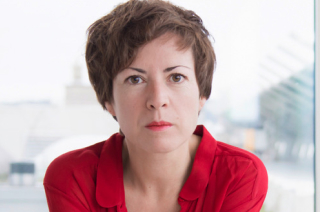AWT
VIDEO
WOMAN WAS THE SUN
Curated by Chus Martínez
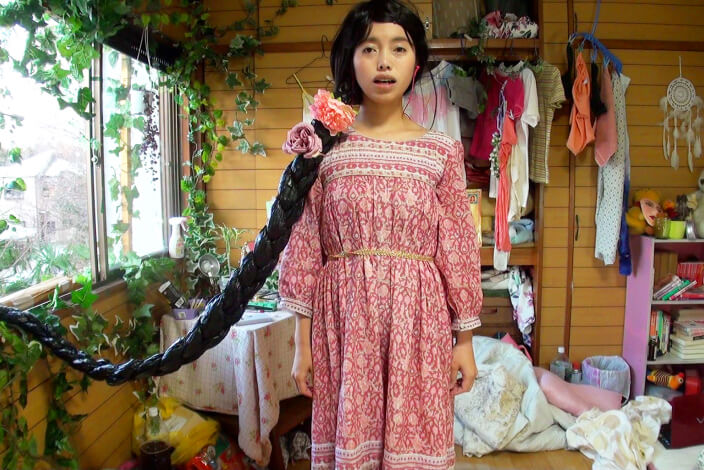
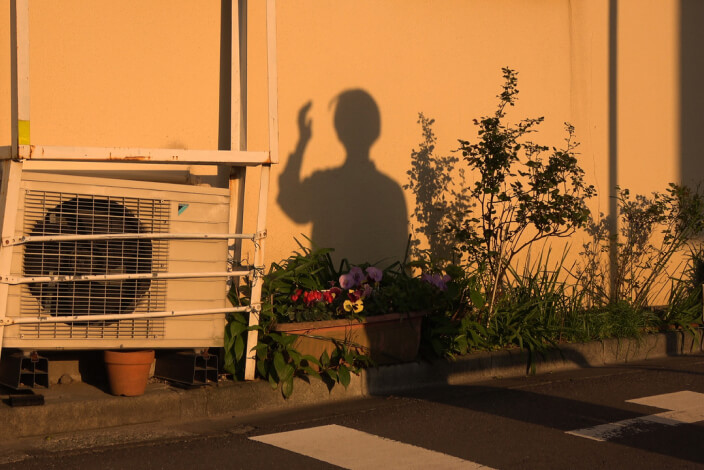
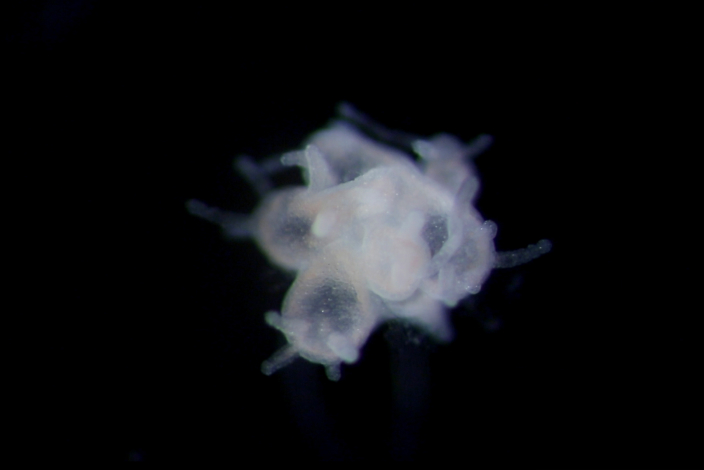
On view November 2–5 at SMBC East Tower in Marunouchi, AWT Video presents a selection of single-channel moving-image works by Japanese and international artists drawn from Art Week Tokyo’s participating galleries. Curated by Chus Martínez, Head of the Institute Art Gender Nature at Basel Academy of Art and Design FHNW, this year’s program, “Woman Was the Sun,” features 17 works by 14 artists.
Download the program (PDF 0.2MB)
CURATORIAL STATEMENT
The video program’s theme is inspired by the title of the autobiography of Japanese thinker Raicho Hiratsuka (1886–1971), In the Beginning, Woman Was the Sun. Among the many possible interpretations of the title of this wonderful book, one strikes me as very compelling today: learning how to change states is difficult yet vital to ensuring future life. Before being human, we were the sun; after being human, we may go on to become a dream, water, a pond, a spirit, language. The ability to challenge our given identities by remaining in permanent transformation is a technology in itself. Art, and especially video art, is the language that unites ancient wisdom with the fantasies and anxieties that determine and drive our present.
The common denominator linking the works in this video program—organized in three groups to facilitate viewing—lies in the trust the artists place in their images, which allows viewers to suspend interpretation and enter into different states of consciousness. In doing so, the divisions between real and nonreal, human and nonhuman, present and past, dream and wakefulness become mere artificial constructs. Truth: to penetrate the future, the first thing we need to do is to penetrate diverse realms of life, to become a river, to inhabit a dream, to be another. This is an exercise for learning to survive control and sustain oneself. What’s the point of all this? To overcome loneliness, to taste the sweetness of experience, generosity, and care.
Born in Spain, Chus Martínez has a background in philosophy and art history. She is currently Head of the Institute Art Gender Nature at Basel Academy of Art and Design FHNW; Associate Curator at TBA21–Academy, headquartered in Madrid; and Curator-at-Large of the Vulsat Foundation, Istanbul.
Martínez has held leadership positions at art institutions across the world, including Chief Curator, El Museo del Barrio, New York; Head of Department, documenta 13, Kassel; Chief Curator, Museu d’Art Contemporani de Barcelona; Director, Frankfurter Kunstverein; and Artistic Director, Sala Rekelde, Bilbao. In 2021–22 she was Curator of TBA21–Academy’s Ocean Space in Venice, Italy. Her curatorial projects in 2023 include “Living in Joy” at Art Sonje Center, Seoul.
Photo by Nici Jost
Participating Artists
Charlotte Dumas
-
YORISHIRO
2020
Digital color video, sound
13 min., 51 sec.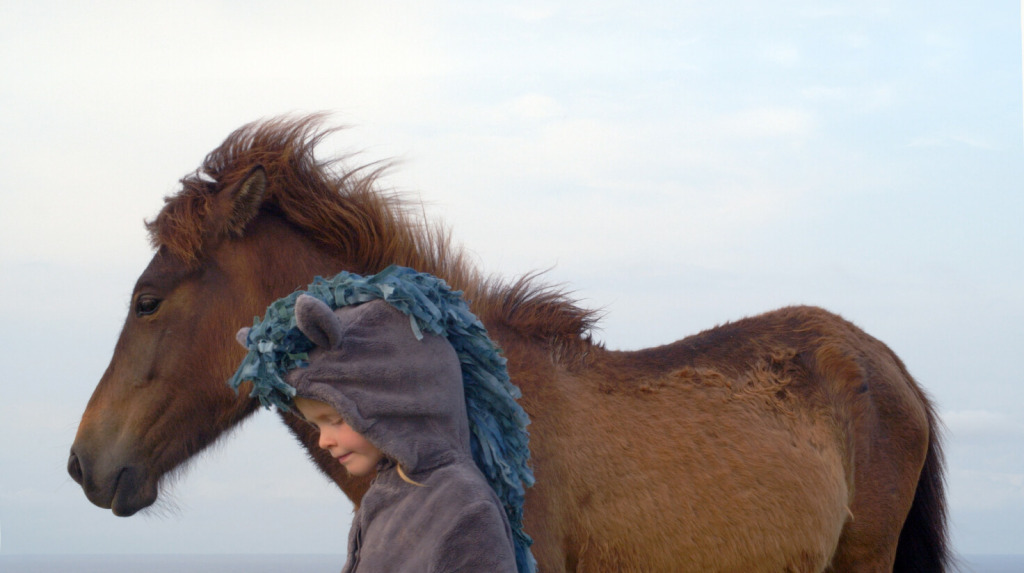
© Charlotte Dumas, courtesy Tomio Koyama Gallery For more than two decades, Charlotte Dumas has focused her attention on animals that maintain a close relationship with humans, such as horses and rescue dogs. Yorishiro is set on Yonaguni, a small and historically charged Japanese island where wild horses still freely roam. The film depicts a little girl in a horse costume as she explores the island and acts as an intermediary between animals and humans. Instead of attributing human characteristics to the wild horses, the girl meets them on equal terms. Light and accessible in tone, Yorishiro is the second film Dumas shot on Yonaguni after Shio (2018), in which the horses and a Japanese girl seem to be waiting for something or someone.
About the Artist
Charlotte Dumas was born in Vlaardingen, the Netherlands, in 1977, and is based Amsterdam. After graduating from the Gerrit Rietveld Academie, Amsterdam, she went on to study at the Rijksakademie, also in Amsterdam. Through her works Dumas seeks to capture the coexistence of animals and humans in contemporary society and the beauty of life’s ephemeral moments. In 2014 Dumas initiated an ongoing project to photograph the native horses of Japan. Her 2020 solo exhibition at Tokyo’s Ginza Maison Hermès Le Forum, “Bezoar,” featured photographs, films, objects, and an installation of indigo-dyed fabric related to this project.
Rintaro Fuse
-
When to Kiss Names
2021
Digital color video, sound
20 min.
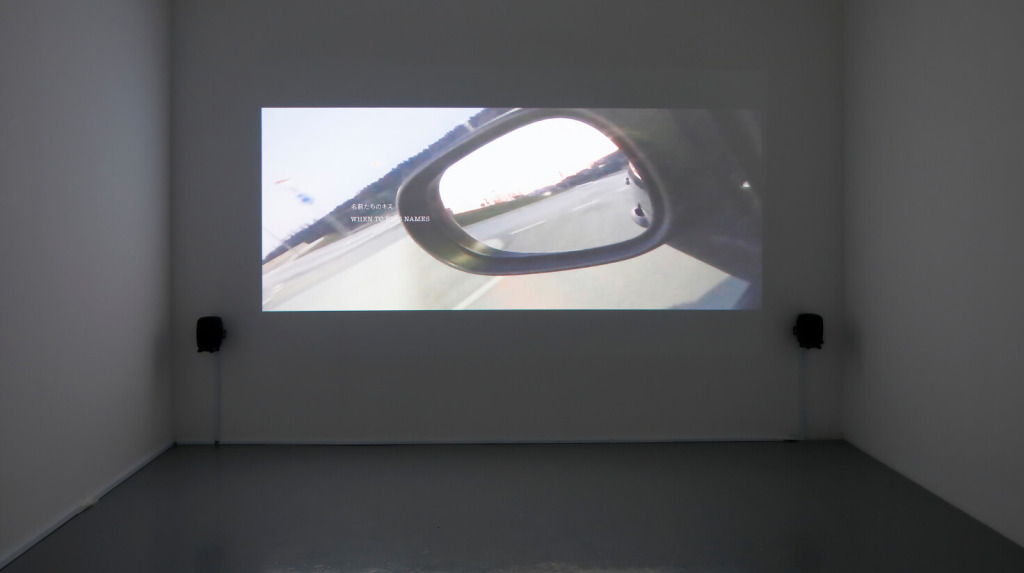
Courtesy the artist and Snow Contemporary When to Kiss Names is based on Rintaro Fuse’s research into dating and matching apps, which experienced a rise in popularity amid the recent social distancing campaigns to limit the spread of Covid-19. Fuse draws inspiration from the anode and cathode, or the positive and negative poles in an electric circuit, as well as Georges Bataille’s concept of “the community of lovers,” which celebrates the debaucherous energies of coupling. Featuring poetry by the artist and music by Yusaku Arai, When to Kiss Names traces the pathways of networked love, the challenges of making contact, and what it means to have a relationship with someone whose real name you don’t know.
About the Artist
Rintaro Fuse was born in Tokyo in 1994 and earned an MFA from the Department of New Media at Tokyo University of the Arts in 2019. Fuse employs diverse mediums in his art practice, including painting, video, iPhones, and prints, and is also active as a curator and critic. Interested in investigating the “new loneliness” that emerged in urban society with the advent of the iPhone, he develops his works through research into topics ranging from information technology to literature and prehistoric art.
REI HAYAMA
-
On the collinear and reflected on the water
2018
Digital color video, sound
3 min., 50 sec.
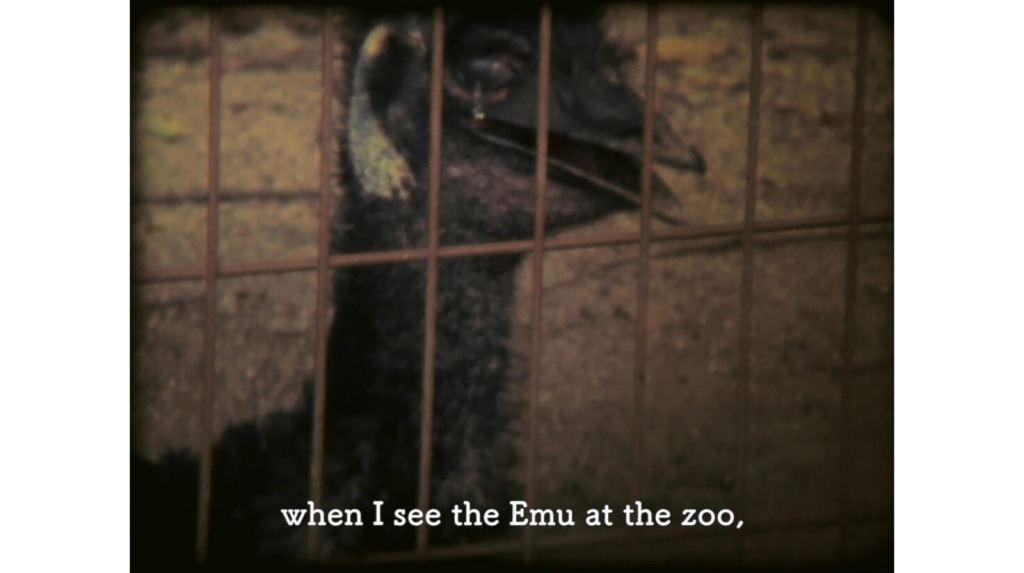
Courtesy the artist and Gallery 38 In On the collinear and reflected on the water, a disembodied voice describing a strangely intimate encounter with an emu is set against projected and rephotographed footage of the bird behind bars at a zoo. Artist Rei Hayama was inspired to make the film when she noticed a tear drop from the corner of the emu’s eye. Her incantatory narration dwells on this moment when she is reflected in the watery eye of the emu, and the emu in hers, as though to compel viewers to confront the animal’s state of captivity and question their own potential for empathy.
About the Artist
Rei Hayama was born in Kanagawa Prefecture in 1987. She began her moving image practice in 2008 while studying in the Department of Moving Images and Performing Arts at Tama Art University, Tokyo. Hayama spent her childhood in a unique environment that allowed her to have frequent interactions with wildlife and environmental problems. Her films revolve around nature and all the living things that get obscured in an anthropocentric worldview. Her works have been exhibited and screened at major venues across the world, including the Bonner Kunstverein, Germany (2022); the National Gallery of Zimbabwe, Harare (2022); Jeu de Paume, Paris (2021); and the Sifang Art Museum, Nanjing (2021). Among other accolades, she was selected as a finalist for the inaugural Commission Project for the 2023 edition of the Yebisu International Festival for Art and Alternative Visons, Tokyo.
MAIKO JINUSHI
-
Brain Symphony
2020
Digital color video, sound
8 min.

© Maiko Jinushi, courtesy Hagiwara Projects Marked by surrealistic imagery and a spare musical score, Brain Symphony opens on a cast of the titular organ, rendered in a transparent medium and inhabited by a parasitic plant. Fingers run along its gyri, as if playing an instrument. Hands cup its sides.
As the video progresses, the parasite is shown growing on other plants, the same hands caress a brain-like stone, and finger-like prostheses attached to a metal armature slowly move around a woman’s head. Through these abstract transpositions, all connected by touch, Brain Symphony journeys between states of dependency and connectivity.
About the Artist
Maiko Jinushi was born in Kanagawa Prefecture in 1984 and earned an MFA from Tama Art University, Tokyo, in 2010. Using personal stories as her starting point, Jinushi makes videos, drawings, and performances that address such fundamental yet elusive human elements as love, desire, and death. She has been featured in solo projects and exhibitions at institutions including the Mori Art Museum, Tokyo (2023); Centre A, Vancouver (2023); and Hospitale Project, Tottori (2020). Major group exhibitions include “Universal/Remote” at the Contemporary Art Museum Kumamoto (2023); the New “Artists Today” Exhibition at the Yokohama Civic Art Gallery (2020); and the Yebisu International Festival for Art & Alternative Visions, Tokyo (2019). In 2020 Jinushi was a resident at Jan van Eyck Academie, Mastricht, the Netherlands.
SHIHO KAGABU
-
Carrier pigeon
2023
Digital color video, sound
4 min., 52 sec.
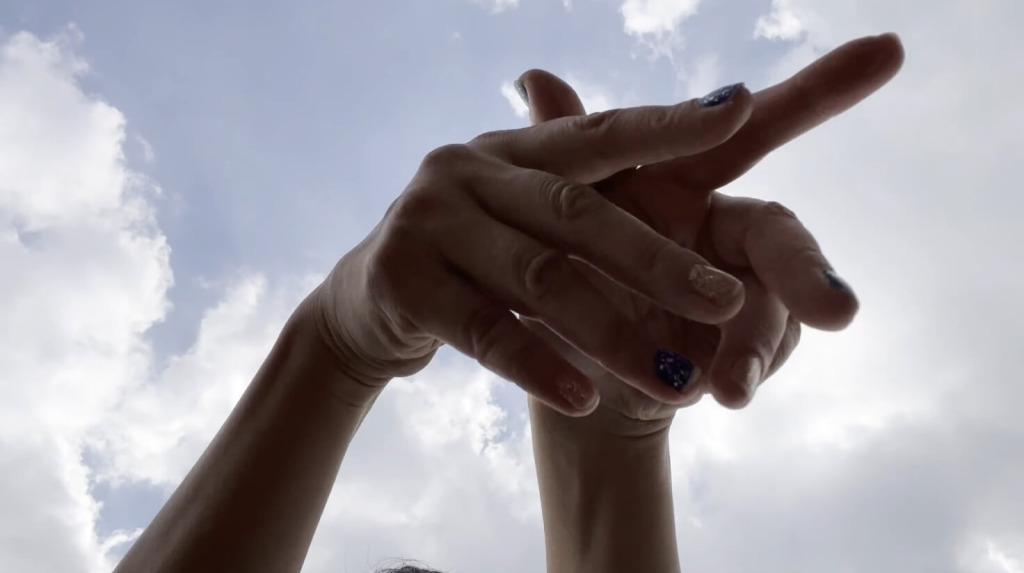
Courtesy the artist and Kayokoyuki In Carrier Pigeon, everyday moments—fallen flowers on wet asphalt, fireworks at night, an endless subway corridor—are enlivened by Shiho Kagabu’s collagist sensibility. Moving through scenes from the artist’s life, the video is as much a carrier as the eponymous pigeon, represented by a pair of hands making flapping motions in the sky. The snippets of audio accompanying the images range from onomatopoetic vocalizations of explosions to an SOS sung in the manner of a children’s song. Viewers might wonder whether the world beyond the frame, fraught with ongoing pandemic and war, is seeping into the soundtrack and footage—and whether the bird Kagabu forms with her hands is actually a dove, taking flight to spread its prayers for peace.
-
The laundress
2022
Digital color video, sound
7 min., 55 sec.
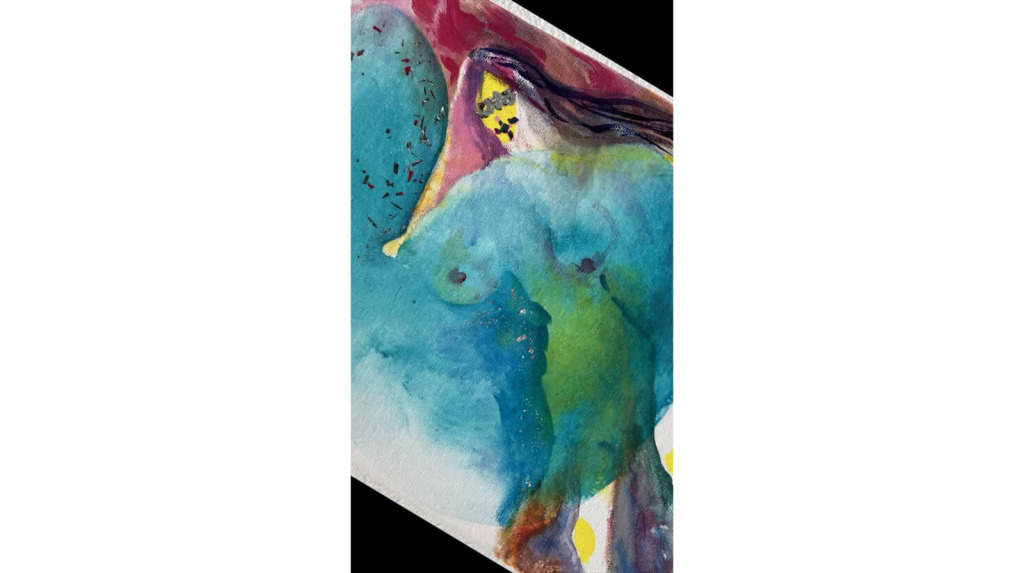
Courtesy the artist and Kayokoyuki The female protagonist of The Laundress scrubs the indoor shoes used in Japanese primary schools, chops vegetables, and does other household tasks traditionally regarded as women’s work. With a sensitive and poetic touch, artist Shiho Kagabu associates this sphere of gendered labor with flows of water, sewage, and thought. Amid the drudgery are intimations of both joy and gloom. The Laundress takes its name and subject from a 1733 painting by Jean Siméon Chardin. It also draws inspiration from Japanese folktales like Momotaro and a Milanese laundry that operated from the 1700s to the 1950s in a neighborhood where Kagabu once lived.
About the Artist
Shiho Kagabu was born in Kanagawa Prefecture in 1981 and earned an MFA in Sculpture from Tama Art University, Tokyo, in 2007. She makes installations, videos, performances and other works by dismantling disused and broken waste material and then recombining the parts into spatial arrangements that produce new kinds of relationships. She has held solo exhibitions and projects at venues including Templo del Futuro Perduto, Milan (2018), NADiff a/p/a/r/t, Tokyo (2013), and the Fuchu Art Museum, Tokyo (2010). Her work has been featured in group exhibitions including the 23rd Domani: Art of Tomorrow at the National Art Center, Tokyo (2021), and Artist File 2013, also at the same venue, as well as the Tokorozawa Biennial of Contemporary Art (2009, 2011). In 2017–18 Kagabu lived and worked in Milan for two years as a recipient of an Agency for Cultural Affairs Oversea Research Program Grant.
KHVAY SAMNANG
-
Calling for Rain
2021
Digital color video, sound
30 min., 42 sec.
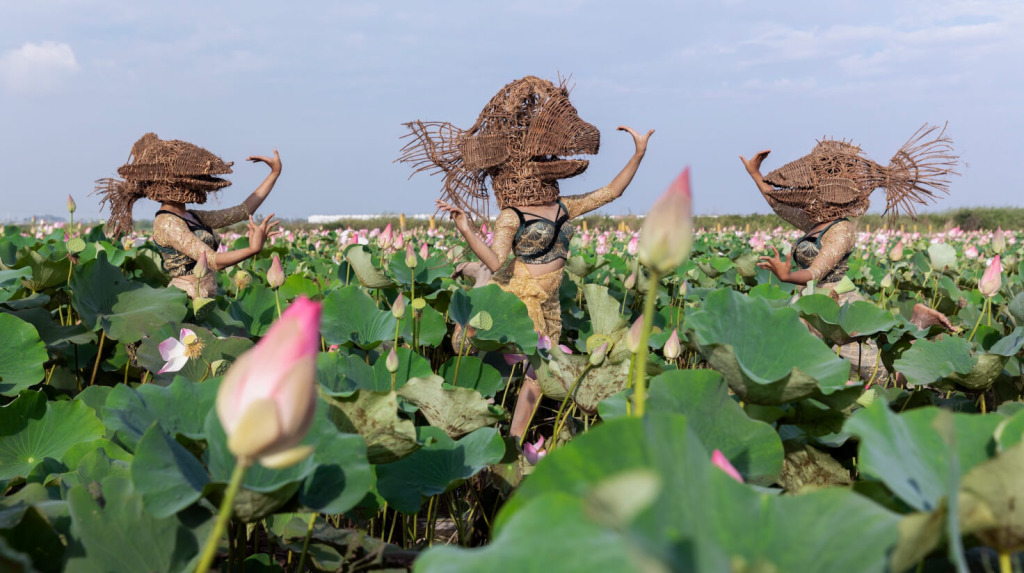
© Khvay Samnang, courtesy Tomio Koyama Gallery Drawing inspiration from Reamker, the Cambodian version of the Sanskrit epic Ramayana, Calling for Rain follows the quest of Kiri the Monkey after the loss of his home due to the destruction of the forest. As the narrative unfolds, it becomes clear that the problems of the forest and its surrounding fields and rivers are linked to the irresponsible behavior of Aki the Fire Dragon. With the help of his friends and KongKea the Fish, Kiri summons his strength and calls for rain to stop the fire, bringing about a change in Aki in the process. Calling for Rain was commissioned by National Gallery Singapore for the 2021 Gallery Children’s Biennale.
About the Artist
Khvay Samnang was born in Svay Rieng, Cambodia, in 1982 and graduated from the Painting Department at the Royal University of Fine Art in Phnom Penh in 2006. Grounded in community engagement and a consideration of history, his works take a variety of forms, from sculptures to installations, videos, and performances. Khvay has exhibited widely at venues across the world, including Haus der Kunst, Munich (2018); Jeu de Paume, Paris (2015); and CAPC Musée d’art contemporain de Bordeaux (2015). He has also participated in numerous international exhibitions, including the 2017 and 2022 editions of documenta, Kassel (on the latter occasion as a member of the artist collective Sa Sa Art Projects). His works are held in major institutional collections, including the National Gallery of Australia, Canberra, and the Singapore Art Museum.
EIKI MORI
-
Shibboleth—I peep the ocean through a hole of the torn cardigan
2020
Digital color video, sound
5 min., 55 sec.

© Eiki Mori, courtesy Ken Nakahashi To make this video, Eiki Mori wrote 15 shibboleths related to the types of everyday events that often pass before one can give language to them. He invited 25 friends of different backgrounds to choose their favorite phrases, each reciting two variations with differing amounts of detail. Their voices sound against a black background, with snippets of footage—a person sleeping, a shoreline—appearing as they finish speaking. Mori has described how, through the accumulation of voices, his work creates an “intimate sound,” which might arrive like a whisper or a distant call and then echo through the bodies of listeners.
-
Shibboleth—I blink my eyes to the heartbeats
2020
Digital color video, sound
7 min., 10 sec.
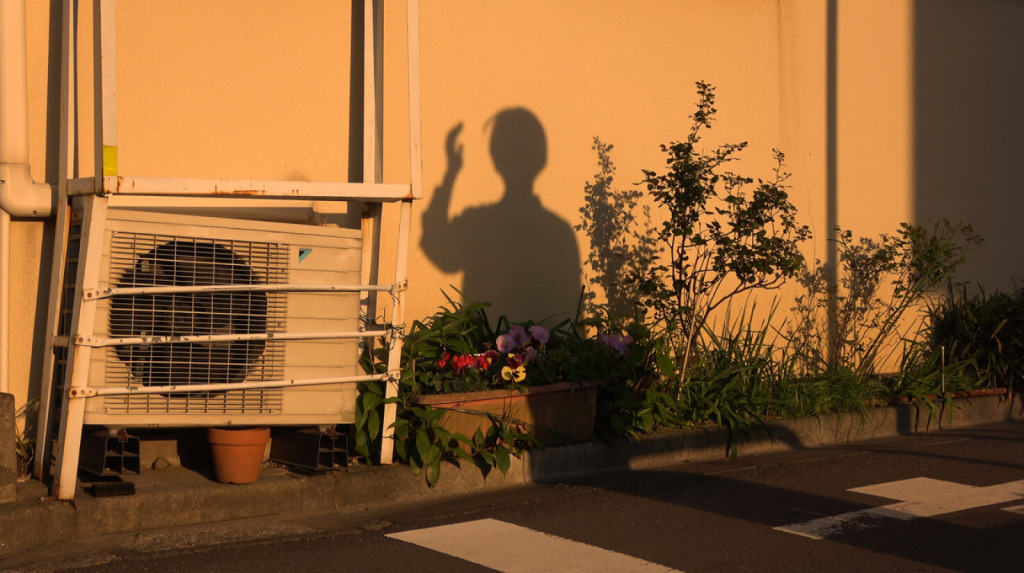
© Eiki Mori, courtesy Ken Nakahashi At the onset of Covid-19 regulations in the spring of 2020, Eiki Mori staged 15 solitary performances on empty street corners. Each took place around sunset, with the artist appearing as a silhouette cast against various surfaces, including a fence, a water tank, concrete pillars, and the gaps between buildings. Mori’s performances derive from “mots de passe” (passwords), such as “I blink my eyes to the heartbeat” and “I turn three pages instead of saying sorry,” which he translated into physical movements. The experience, he remarks, is like “reading a poem with my body,” giving form to feelings and memories associated with “those who can’t meet anymore, those who cannot meet easily, and those who will meet in the future.”
About the Artist
Eiki Mori was born in Kanazawa in 1976 and currently lives and works in Tokyo. He graduated from the Photography Department at Parsons School of Design, New York, in 2001. Mori pursues an expanded art practice that encompasses photography, performance, sound installation, videos, drawings, poems, and short stories. He has exhibited at major institutions across Japan including the Takamatsu Art Museum, Kagawa Prefecture (2022); the 21st Century Museum of Contemporary Art, Kanazawa (2021); and the Tokyo Photographic Art Museum (2018). In 2014 he was the recipient of the 39th Kimura Ihei Award, one of Japan’s highest accolades for photography.
HIROKO OKADA
-
EXERCISES
2014
Digital color video, sound
8 min., 48 sec.
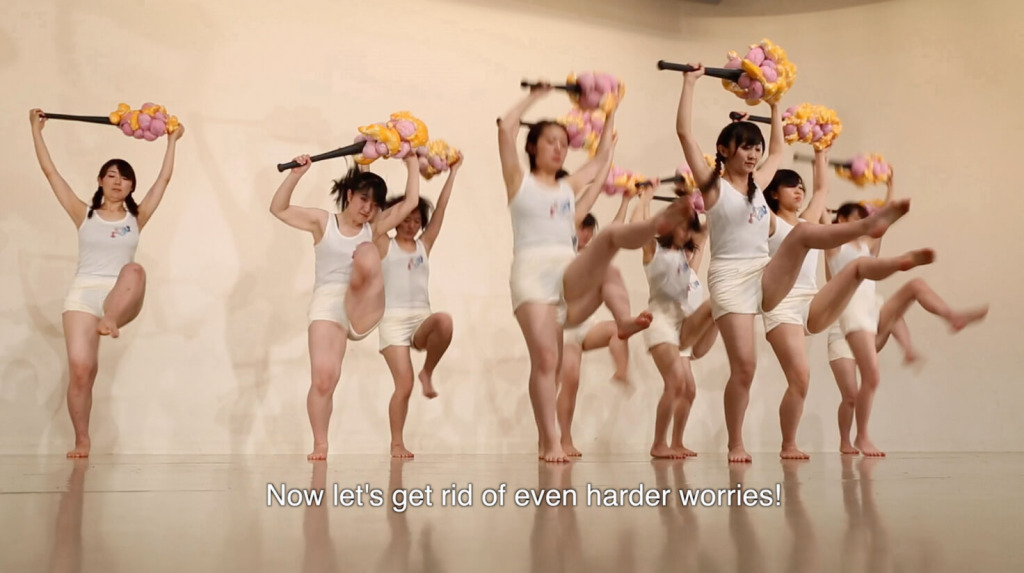
© Hiroko Okada, courtesy Mizuma Art Gallery EXERCISES mimics the calisthenics routines that have been broadcast every morning over the radio in Japan since before World War II, and which are still employed in the education system today. Comprising a series of movements that work the muscles and relax the body, the traditional routine aims to keep participants in good health. Hiroko Okada takes this ambition to absurd extremes, offering exercises for smartphone stress, various forms of unease, and even preparation for death. By seeking to remedy these contemporary psychological stresses, the artist questions how Japanese society became, as the video’s voiceover states, “one of the most stressed in the world.”
About the Artist
Born in Tokyo in 1970, Hiroko Okada uses a variety of expressive techniques to convey messages to contemporary society. Her work is on permanent display at the Ars Electronica Center, Linz, Austria (2019–), and has been included in major thematic exhibitions worldwide, such as “Lesson 0” at the National Museum of Modern and Contemporary Art, Gwacheon, Korea (2017), and “Global Feminisms” at the Brooklyn Museum, New York (2007). In 2022, Okada held a solo exhibition at Yonago City Museum of Art in Tottori Prefecture and participated in a group exhibition at the Museum of Contemporary Art of Vojvodina in Novi Sad, Serbia. Her latest work is on view at Para & Bigakko Studio, Tokyo, through December 26, 2023. In addition to her individual practice, Okada leads diverse art collectives, including the alternative puppet theatre company Gekidan★Shiki, the two-person unit W Hiroko Project, and Aida Family, formed with her family members.
AKI SASAMOTO
-
Weather Bar #1
2021
Digital color video, sound
4 min., 47 sec.
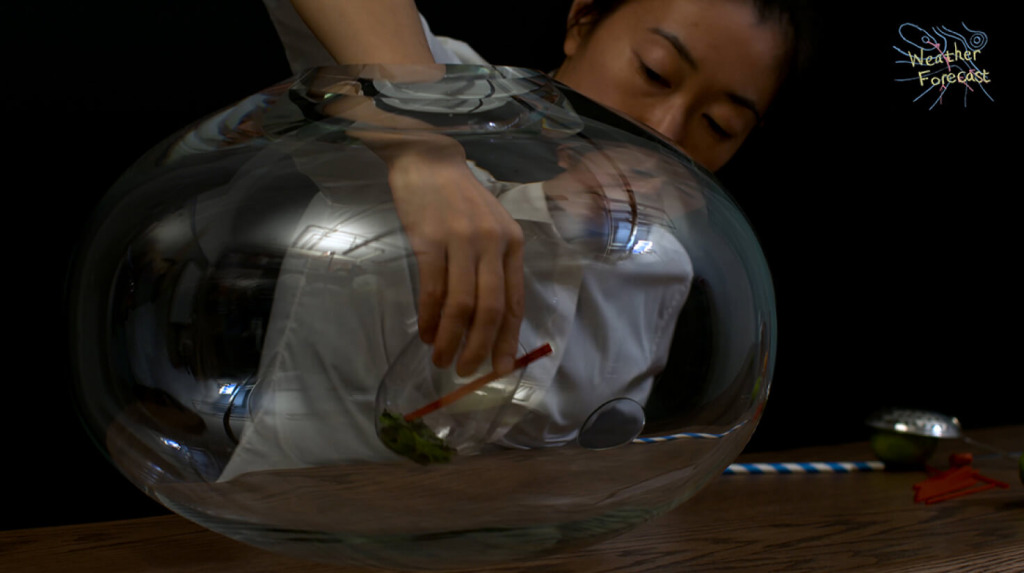
© Aki Sasamoto, courtesy Take Ninagawa Narrated by an insouciant voiceover, Weather Bar #1 incongruously combines the evening weather report with the accoutrements of a cocktail bar to show how ecological systems span from microcosmic to global scales. In the artist’s own description, “This bar is to serve a lonesome customer, one person or a small group. The bar will serve a ‘drink,’ a phenomenon of spinning of a whiskey glass.…As the forecasts unfold, science and mystery are fused with much satire [of] recent abnormal world events and climate changes.”
-
Do Nut Diagram
2018
Digital color video, sound
20 min., 1 sec.
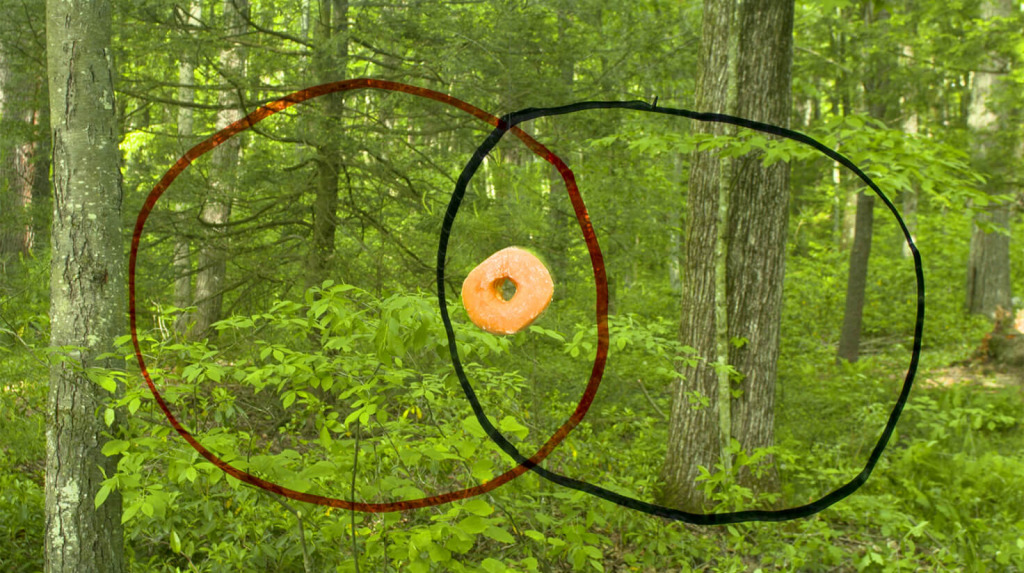
© Aki Sasamoto, courtesy Take Ninagawa Commissioned and produced by Triple Canopy, an online publishing initiative, Do Nut Diagram opens on the deadpan scene of a donut seemingly floating in the middle of a forest to the accompaniment of an eerie, pulsating woodwind score. This is the prelude to a wordless meditation—unfolding with the aid of magic markers, window cleaner, and yet more donuts—on the entangled relations between reality, perception, and knowledge as mediated by the apparatus of the screen. Evoking the classics of experimental film, Sasamoto employs disarmingly simple gestures and effects to shatter viewers’ expectations about the integrity of the events they are witnessing.
About the Artist
Born in Yokohama in 1980, Aki Sasamoto is a New York–based Japanese artist who works in performance, sculpture, dance, and video. Her videos often develop in tandem with her performance/installation pieces, in which improvisational performances combining spoken narrative and physical contortions unfold in a feedback loop with careful arrangements of sculpturally altered found objects and multimedia elements. Sasamoto’s institutional solo exhibitions include the Queens Museum, New York (2023); the Kitchen, New York (2017); and SculptureCenter, New York (2016). She has participated widely in international exhibitions including the 59th Venice Biennale, the Aichi Triennale, the Busan Biennale, and the Okayama Art Summit (all 2022) as well as the Kochi-Muziris Biennale (2016) and Yokohama Triennale (2008).
YUKI SHIMIZU
-
The River of Resurrection
2023
Digital color video, silent
10 min., 56 sec.
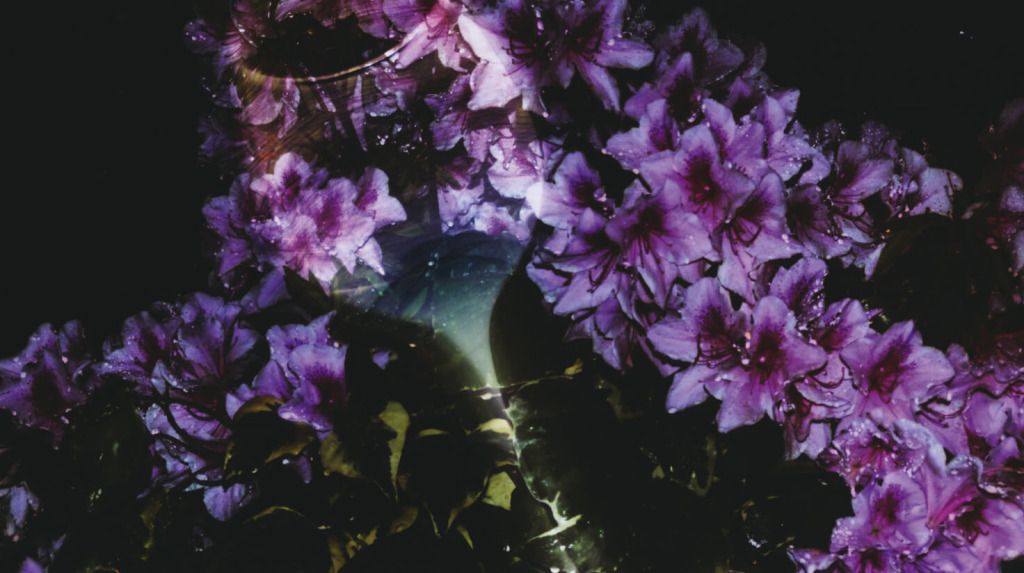
© Yuki Shimizu, courtesy PGI The River of Resurrection is a story of loss told through a montage of still images and subtitles. Recounting the watery suicide of their sister, the video’s narrator builds a world of magical realism and transient identity in which dogs and catfish can speak.
Illustrating this story are shots of Tokyo’s Kanda River as well as slow pans across photograms, which superimpose detritus found in nearby Shinjuku on photographs taken in the area. The narrator suggests that their sister made these images, some of which appear to composite her face with the bodies of other women. Caught in eddies of grief, Shimizu’s work questions whether photography can be an art of preservation and even resurrection.
About the Artist
Yuki Shimizu was born in Chiba in 1984 and graduated from Musashino Art University, Tokyo, in 2007. Starting with her debut solo show in 2012 at Guardian Garden, Tokyo, she has developed a unique practice weaving together photography and text to produce intricate fictions built on research into local histories and folklore. Her accolades include the Grand Prize at the 5th 1_Wall Exhibition in 2011 and the 18th Miki Jun Award in 2016. In 2018 she received the R-18 Literary Award for her work as a novelist.
YUKIHIRO TAGUCHI
-
Okuri-mizu
2018
Digital color video, sound
10 min., 1 sec.
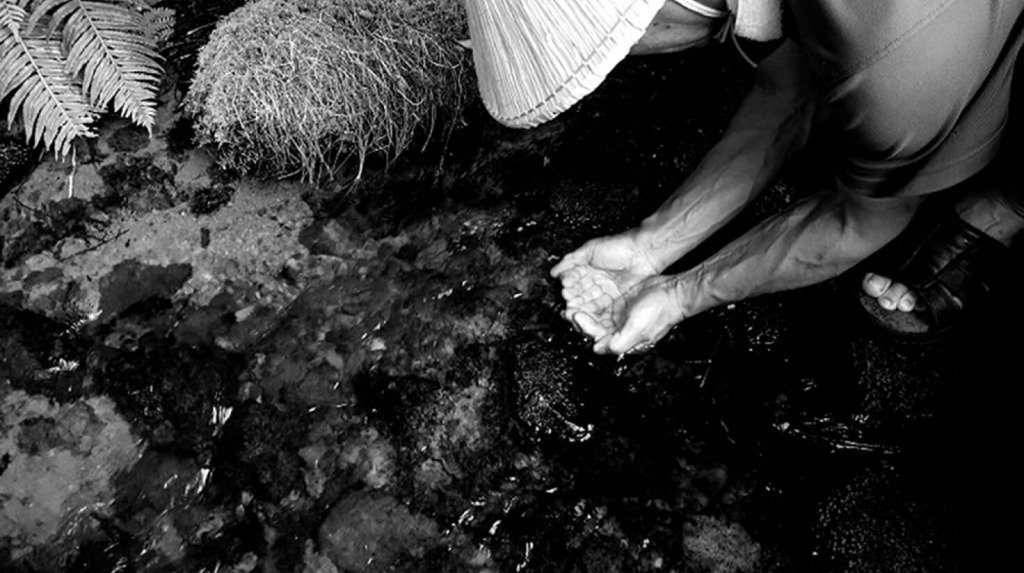
© Yukihiro Taguchi, courtesy the artist and Mujin-to Production Okuri-mizu was shot at Ryugakubo, a pond that features in various ryujin (dragon god) folktales. Over three slow vignettes set to the sounds of the natural world, the video shows water from the pond being passed from hand to hand and finally deposited in a wooden bucket. What emerges from these scenes is a sense of collective investment in the task, as shown by the care people take to ensure that water isn’t lost when traveling between hands. At the conclusion of the video, a man takes the bucket to a field and sprinkles the water over the crops. Though likely not enough to irrigate the plants, this water carries enormous symbolic weight for the way it was collected.
About the Artist
Yukihiro Taguchi was born in Osaka in 1980 and lives and works in Berlin, Germany. He is widely known for his unique performative installation practice, which combines elements of drawing, performance, animation, and installation, and takes inspiration from the features and histories of the locations where he works.
FUYUHIKO TAKATA
-
Dream Catcher
2018
Digital color video, sound
5 min., 32 sec.
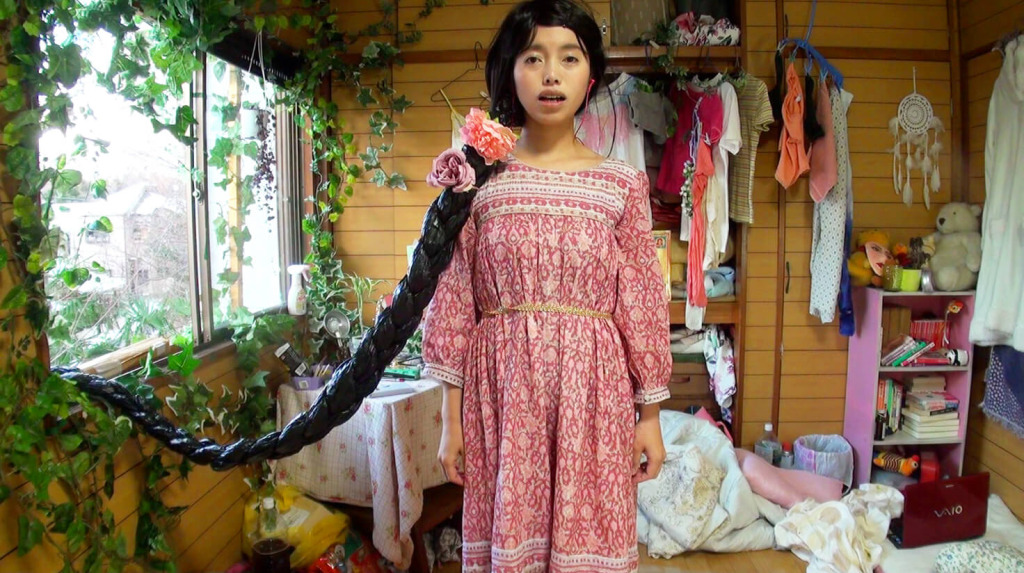
© Fuyuhiko Takata, courtesy the artist and Waitingroom Dream Catcher is a modern take on the fairy tale of Rapunzel, staged between miniature and life-size sets with a performance by artist Mai Endo. The video opens on the protagonist trapped in a tower, her famously long hair extending across the two sets. When she sings “Someday My Prince Will Come,” the tower grows taller. Rapunzel then begins to spin and retract her hair, which wraps around her body and turns her into a cocoon-like mass. She may hope to snare a passing prince, but in the process, her hair wreaks havoc on the world beneath the tower. The force of her desire is both transformative and destructive.
About the Artist
Fuyuhiko Takata was born in Hiroshima in 1987 and lives and works in Chiba. He makes self-produced cinematic works with vibrant narratives evoking myths, legends, fairy tales, and other fantasy worlds. In 2019 his work was featured in a solo project for the MAM Screen program at the Mori Art Museum, Tokyo. He has also participated in group exhibitions at institutions including the Japan Foundation Sydney (2022), the Kyoto City University of Arts Gallery (2021), and the Museum of Contemporary Art Tokyo (2016).
MAIJA TAMMI
-
The Problem of the Hydra
2020
Digital color video, sound
9 min., 44 sec.
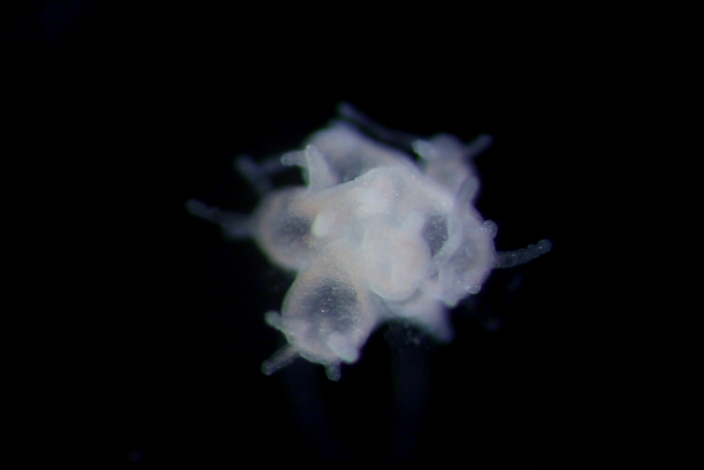
© Maija Tammi, courtesy Kana Kawanishi Gallery The Problem of the Hydra explores the practical and metaphysical questions raised by the Hydra vulgaris. Called an enigma in the 1700s, this small, freshwater polyp is capable of sexual reproduction, cloning, and regeneration, and never ages. A voiceover read by Ava Grayson charts centuries of research into this creature, noting that it remains somewhat of a mystery to this day. Accompanied by Charles Quevillon’s sound design, the video’s footage supports this observation, revealing the hydra’s confounding capacities at a striking level of detail and visualizing the possibility of existing outside the binary of life and death.
About the Artist
Born in Helsinki in 1985, Maija Tammi is a Finnish artist whose photographs, sculptures, and video installations examine the borders of mortality and immortality, science and aesthetics. Tammi’s work has been exhibited widely at venues in Paris, Berlin, London, New York, Rome, and Tokyo, and she has published five books to date. In 2017 Tammi earned a Doctorate of Arts from the School of Arts, Design and Architecture at Aalto University, Espoo, Finland. She holds a five-year grant and the honorary title Artist Professor for the years 2020–24.
W HIROKO PROJECT
-
Di_STANCE
2021
Digital color video, sound
5 min., 7 sec.
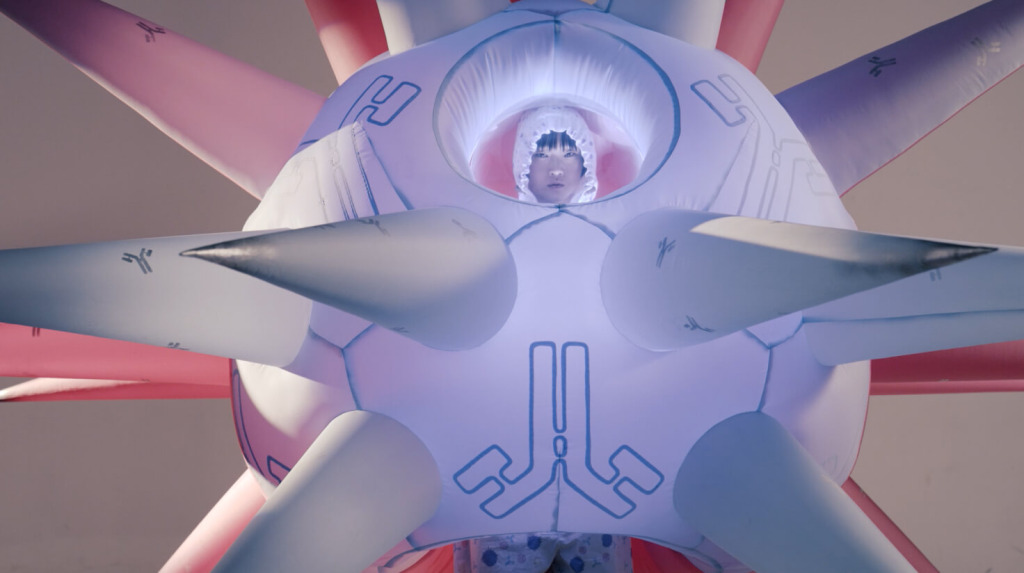
© W Hiroko Project A shape-changing garment called Di_STANCE is the focus of this video, which explores the dynamics of sociality in the Covid-19 age. Created by W Hiroko Project, the item situationally allows for both social distancing and sharing intimacy with loved ones. It is capable of being inflated to a large spiked sphere—bearing an unmistakable resemblance to the coronavirus—or deflated to the size of a backpack.
Model Mioko plays two characters in the video: one who wears and inflates Di_STANCE like a survival mechanism, and another who removes her face mask and reaches out a hand in an attempt to make contact. The wearer deflates the garment and returns the gesture, a smile breaking on her face. A response to the loneliness brought on by pandemic regulations, Di_STANCE longs for a future when social distancing will no longer be necessary.
About the Artist
W Hiroko Project was established by fashion designer Hiroko Ito and artist Hiroko Okada in 2020 in response to the widespread uncertainty caused by the Covid-19 pandemic. Asking “What can we do now?,” the artists pursue the concept Art × Fashion × Medical in collaboration with other like-minded creators. The project began with the artists’ development of masks and protective gowns that draw upon fashion design, followed by the creation of a monumental dress, Di_STANCE (2021), inspired by people living through the pandemic. Currently, W Hiroka Project is at work on a conceptual experiment to create spaces for the elderly artists of the future.
